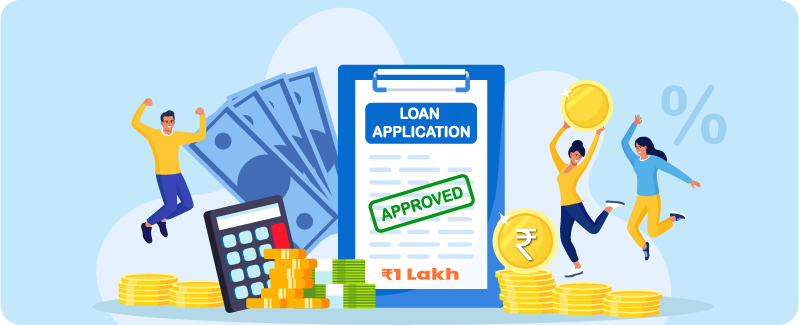- Published on: 23 Jul 2025
- Last updated on: 11 Dec 2025
- Post Views: 6647


Whether it’s a medical emergency, home repair, education fee, or travel plan, sometimes all you need is a quick ₹1 lakh to bridge the gap. Getting a ₹1 lakh personal loan from DMI Finance is now faster, easier, and more accessible than ever before.
With the growing demand for small-ticket personal loans in India, borrowers are increasingly choosing digital loans. According to the Fintech Association for Consumer Empowerment (FACE), digital lending disbursals witnessed 49% growth in FY24.
In this guide, we’ll walk you through how to get a ₹1 lakh personal loan, who can apply, what documents you’ll need, how much you might repay, and why DMI Finance could be the ideal option for you.

A ₹1 lakh personal loan is ideal for:
Such loans are also ideal for individuals who want to avoid using their savings or investments to cover a temporary financial emergency.
When you apply for a ₹1 lakh loan, especially with DMI Finance, you could get these benefits:
Small-ticket loans, such as ₹1 lakh, are ideal to build your credit profile without long-term obligations.

Here’s a quick look at who qualifies:
| Criteria | Details |
| Age | 23 to 52 years |
| Monthly Income | ₹25,000 or more |
| Employment Type | Salaried or Self-employed |
| Minimum Credit Score | 700 |
To apply for a ₹1 lakh loan, you typically need the following:
Applying for a ₹1 lakh personal loan from DMI Finance is as simple. Here’s the step-by-step application process:
Your application will be submitted for review, and you’ll be notified of approval shortly.
Here’s what your EMI might look like for a ₹1 lakh loan:
| Loan Amount | Tenure | Interest Rate (approx.) | Monthly EMI | Total Payable |
| ₹1,00,000 | 12 months | 14.25% p.a. | ₹8,990 | ₹1,07,886 |
Note: This is a sample calculation. Actuals may vary based on eligibility and lender terms.
Use an EMI Calculator to check your personalised repayment plan.

Here’s why lakhs of borrowers trust DMI Finance:
A ₹1 lakh personal loan can be the perfect solution for short-term needs, whether it’s a medical emergency, home improvement, or a big purchase. With NBFCs like DMI Finance, the process is simple, digital, and transparent.
Responsible borrowing starts with understanding your eligibility, comparing options, and choosing a lender who prioritises your convenience and safety.
Need just ₹1 lakh for your immediate needs? With DMI Finance, the process is fast, digital, and designed for you. Click here to apply.
1. Can I get a ₹1 lakh loan with a ₹25,000 monthly salary?
Yes, if you meet other criteria such as age, employment, and credit score. DMI Finance offers personal loans to individuals earning ₹25000 per month.
2. What is the interest rate on a ₹1 lakh loan?
Rates depend on the lender and the applicant’s credit profile. At DMI Finance, rates are competitive and transparent.
3. Do I need collateral for a ₹1 lakh personal loan?
No, a ₹1 lakh personal loan is usually unsecured, meaning you don’t have to pledge any assets such as property or gold.
4. Can I apply online with Aadhaar and PAN only?
Yes, with DMI Finance, a digital application with Aadhaar and PAN is accepted.
5. Can I repay my loan early?
Yes. You can foreclose or prepay based on the lender’s terms. Check for applicable charges.
Also read: Foreclosure or EMI Payment. Which one is better?
6. What is the minimum eligibility for a ₹1 lakh personal loan?
To apply for a ₹1 lakh personal loan, the general eligibility criteria are:
7. How fast can I get a ₹1 lakh personal loan online?
After your loan application is approved, you can expect to receive the loan amount within 24 to 72 hours.
8. Can I get a ₹1 lakh loan with no credit history?
Some NBFCs do provide loans to first-time borrowers with thin or no credit history. However, the approval may depend on your income, employer type, and overall risk profile.
| Personal Loans of Different Amounts | |
| ₹50,000 Personal Loan | ₹2 Lakh Personal Loan |
| ₹3 Lakh Personal Loan | ₹4 Lakh Personal Loan |
| ₹5 Lakh Personal Loan | |


